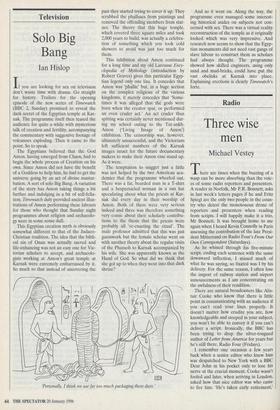Television
Solo Big Bang
Ian Hislop
If you are looking for sex on television don't waste time with drama. Go straight for history. Trailers for the opening episode of the new series of Timewatch (BBC 2, Sunday) promised to reveal the dark secret of the Egyptian temple at Kar- nak. The programme itself then teased the audience for quite a while with mysterious talk of creation and fertility, accompanying the commentary with suggestive footage of volcanoes exploding. Then it came to the point. So to speak.
The Egyptians believed that the God Amon, having emerged from Chaos, had to begin the whole process of Creation on his own. Since Amon did not have the benefit of a Goddess to help him, he had to get the universe going by an act of divine mastur- bation. A sort of solo Big Bang. A variation of the story has Amon taking things a bit further and indulging in a bit of self-fella- tion. Timewatch duly provided ancient illus- trations of Amon performing these labours for those who thought that Sunday night programmes about religion and archaeolo- gy were in some sense dull.
This Egyptian creation myth is obviously somewhat different to that of the Judaeo- Christian tradition. The idea that the bibli- cal sin of Onan was actually sacred and life-enhancing was not an easy one for Vic- torian scholars to accept, and archaeolo- gists working at Amon's great temple at Karnak were extremely embarrassed by it. So much so that instead of uncovering the past they started trying to cover it up. They scrubbed the phalluses from paintings and removed the offending members from stat- ues. The theory that this huge temple, which covered three square miles and took 2,000 years to build, was actually a celebra- tion of something which you took cold showers to avoid was just too much for them.
This inhibition about Amon continued for a long time and my old Larousse Ency- clopedia of Mythology (introduction by Robert Graves) gives this particular Egyp- tian legend only one line. It concedes that Amon was 'phallic' but, in a huge section on the complex religions of the various kingdoms, it merely concedes that 'Some- times it was alleged that the gods were born when the creator spat, or performed an even cruder act.' An act cruder than spitting was certainly never mentioned dur- ing my school outing to the Tut-ankh- Amon (`Living Image of Amon') exhibition. The censorship was, however, ultimately unsuccessful, and the Victorians left sufficient numbers of the Karnak images intact for the future documentary makers to make their Amon case stand up. As it were.
The temptation to snigger just a little was not helped by the two American aca- demics that the programme wheeled out. There was a fat, bearded man in a T-shirt and a bespectacled woman in a sun hat speculating about what the priests at Kar- nak did every day in their worship of Amon. Both of them were very serious indeed and there was therefore something very comic about their scholarly contribu- tions to the thesis that the priests were probably all 're-enacting the ritual'. The male professor admitted that this was just guesswork but the female scholar went on with another theory about the regular visits of the Pharaoh to Karnak accompanied by his wife. She was apparently known as the Hand of God. So what did we think that she got up to when they went into that dark shrine?
Personally, I think we use far too much packaging these days.' And so it went on. Along the way, the programme even managed some interest- ing historical asides on subjects not con- cerned with sex. There was a virtual reality reconstruction of the temple as it originally looked which was very impressive. And research now seems to show that the Egyp- tian monuments did not need vast gangs of slave labour to construct them as scholars had always thought. The programme showed how skilled engineers, using only sand and mud-bricks, could have put the vast obelisks at Karnak into place. Explaining erections is clearly Timewatch's forte.


























































 Previous page
Previous page